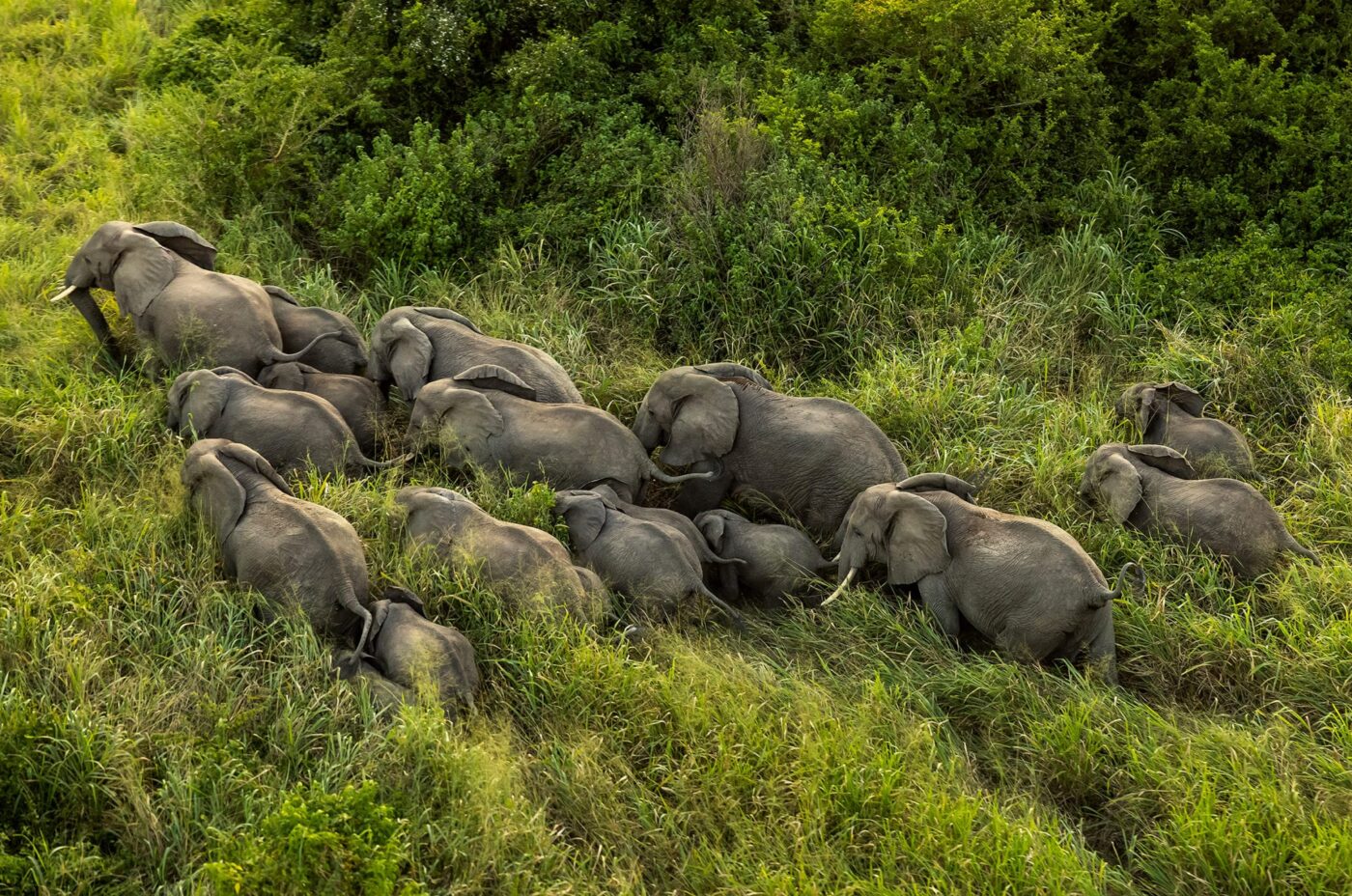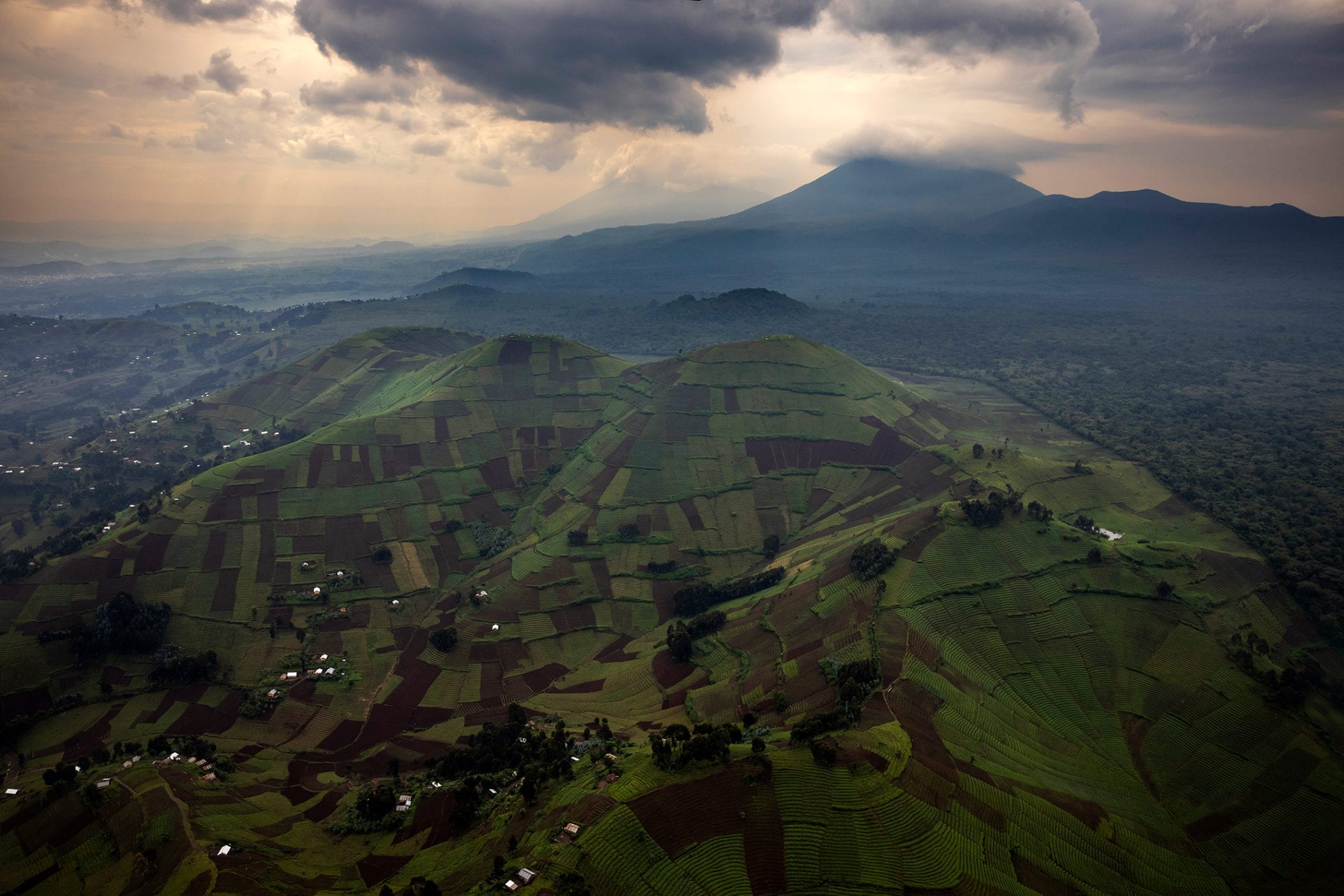
Support Virunga this Giving Season >

Savanna Elephants
The African bush elephant, also known as the savanna elephant is the planet’s largest land animal. It can weigh as much as 7 metric tonnes and live to be seventy years old in the wild. Despite being under threat from the ivory trade, sightings in Virunga are on the rise.
Elephants are described as ‘ecological engineers’ because of their physical effects on ecosystems, from the digging up of riverbeds, through trail making, to the uprooting of trees.
Research shows that areas with more elephant tree damage have greater species abundance. Even their dung is important, dispersing seeds and providing food for dung beetles.
African bush elephants range across Sub-Saharan Africa, excluding dense tropical forests where forest elephants dwell, grazing the plains and bushlands for grass, plants, fruit, and bark. Because of their huge food requirements, they increasingly clash with expanding human civilization, resulting in the decimation of entire crops and retaliatory killings.
Savanna elephants enjoy frequenting water holes, not only to quench thirst caused by the intense African heat, but for spraying themselves in order to cool down.
Often they follow up a shower with a coating of dust which helps protect against parasites, heat and the sun’s UV rays.
Savanna elephants typically gather in herds of around ten females and their calves. Male bulls remain mostly solitary, only joining females when it’s time to mate. The mammal roams huge distances foraging for food, eating up to 300lbs (136kg) of vegetation daily. Tusks are used in mating contests and to dig for food and water.
An extraordinary evolutionary adaptation of the nose, the trunk of an elephant is used to smell, breath, trumpet, drink and grasp, and contains around forty thousand muscles (roughly sixty times more than the entire human body).
African bush elephants also benefit from two opposable finger-like extensions at the tip of the trunk.
The African bush elephant is the largest subspecies of elephant, identifiable by its large, heat-radiating ears and long front legs. Other impressive features include continually growing tusks, present in both males and females, wrinkled skin, which helps with moisture retention in arid African conditions, and of course, its magnificent, flexible trunk.
Physically massive, intelligent, and enduring, savanna elephants are a species symbolic of wild Africa. Their extinction would be a truly devastating loss not only for humankind but the ecosystems that rely on them, making conservation efforts crucial.

In 1930, there were an estimated 10 million elephants across Africa. There are now as few as 415,000, leaving the species vulnerable to extinction.

The ivory trade is the number one threat to elephants across the continent. China’s 2017 ivory ban has reduced international trafficking, but much more needs to be done to protect the species from further decline.

Conflict with humans also threatens elephants, who raid crops, leading to retaliatory killings. Land converted for agriculture makes it harder for elephants to find food and water.

Efforts to foster smarter farming practices and create corridors connecting protected areas are leading to gradual population increase across Africa.

Elephant poaching has been steadily declining for ten years in Virunga. Nine elephant carcasses were found in 2017, six in 2018, and three in 2019.

Thanks to Rangers’ tireless efforts to improve security in the Park’s savanna grasslands, sightings in and around Virunga have increased with elephants congregating close to the Park’s perimeter.

Poverty is a key driver of poaching. Developing sustainable jobs for local people is seen as an effective way to further reduce elephant poaching.
In the 1950s, there were around 8,000 African bush elephants roaming Virunga. Poaching, illegal agriculture and perpetual armed conflict since the mid-90s have led to a decline in the population within the Park’s boundaries.
In 2009, rebel forces began dispersing from the Park, allowing Virunga, its Rangers and local people to work together on developmental initiatives that create conditions favourable to elephants. In 2020, 580 African bush elephants migrated into the Park to form an aggregated herd of 700.
“The return of large elephant herds to Virunga is the outcome of decades of extraordinary efforts on the part of Congo’s Park Rangers,” cites Emmanuel de Merode, Director of Virunga National Park.
As well as being an awesome spectacle, the herds bring benefits beyond the limits of human intervention, rapidly rewilding the overgrown savanna, returning it to grassland and attracting smaller grazing herbivores.
In the wake of COVID-19, its detrimental impact on tourism and the loss of twelve Rangers in a rebel attack in April 2020, the return of elephants is a beacon of hope for Virunga. In the long term, they are expected to drive species diversity, attract tourists and bring further economic opportunities to local people.
Adopt Now
Shop Store
Wildlife
Q. What makes the African bush elephant different from the forest elephant?
A. African bush elephants are larger, with bigger ears and curved tusks, compared to forest elephants, which are smaller with straighter tusks adapted for moving through dense rainforests. Bush elephants prefer open savannas and grasslands.
Q. What do African bush elephants eat?
A. Bush elephants are herbivores that feed on grasses, leaves, fruits, bark, and roots. Depending on availability and the season, they can consume up to 300 kilograms of vegetation and drink around 150–200 liters of water per day.
Q. How long do African bush elephants live in the wild?
A. They can live between 60 and 70 years in the wild, depending on food availability, environmental conditions, and protection from poaching.
Q. How do elephants communicate with each other?
A. Elephants use sounds, body language, and even vibrations felt through the ground to communicate over long distances. Their deep rumbles can travel several kilometers.
Q. What are the main threats facing African bush elephants today?
A. Poaching for ivory, habitat loss, and human-wildlife conflict are the biggest threats to their survival. Conservation efforts in parks like Virunga help protect them.